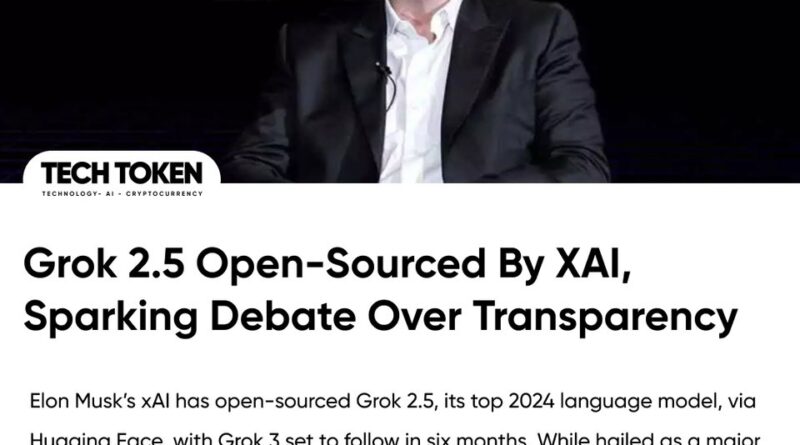Open-washing: The Controversy Behind Grok 2.5’s ‘Open Source’ License
The touted openness of Grok 2.5’s licensing has raised some serious objections. The proclamation about its ‘open-source’ feature appears to be a simple case of surface-level advertising, often labeled as open-washing. This stands in stark contrast to other AI projects that adhere to the principles of open access and independence. There’s a growing trend within companies to make considerable claims about the open-source nature of their AI projects. It’s a strategic move that appeals to the public and arouses the curiosity of inexperienced developers, all while prompting investors to infuse more capital into these ventures. The trouble is that these claims are often misleading.
Previous allegations surfaced stating that Meta Llama was an open-source project. Now, similar assertions have been made about AI startup, xAI, regarding its Grok 2.5 language model, crowning it as the prime model of the previous year. The assertion goes: ‘Our leading model of last year, Grok 2.5, from xAI, has now been open-sourced. Additionally, Grok 3 is slated to be made open-source within half a year’. This announcement is accompanied by the complete model weights publication.
One may wonder, what makes a corporation decide to take such a step? The unofficial argument points towards an effort to gain traction and broaden the consumer base for Grok, bypassing its competitors. This methodology, often termed as open-washing, involves encouraging the belief that a product is open-source without necessarily making the source code openly accessible.
However, on the official front, it’s declared that going open-source is a stride towards increased transparency, with a call for a larger number of developers to contribute to the codebase. The unofficial stance is that xAI would gladly incorporate any valuable modifications brought upon by individual contributors. It’s important to note, though, that this is a standard expectation from any open-source undertaking.
But here’s where things become controversial. The licensing agreement of Grok has a fundamental condition that clearly limits the ‘openness’ of the model: ‘You are prohibited from using these tools, derivatives, or outputs (which includes generated data) to foster, create, or improve any foundational, large language, or general-purpose AI models, with exceptions only for Grok 2 modifications or fine-tuning as defined by this Agreement’s stipulations.’ It’s clear that the open-source claim is not entirely accurate.
As a keen observer remarked aptly, this limitation implies: ‘It’s not genuinely ‘open-source’ since the primary source isn’t accessible.’ ‘The weights aren’t ‘open’ as they come attached with usage restrictions.’ ‘This model essentially makes the weights available. There’s no true openness associated.’ This comment captures the essence of the situation perfectly.
Without even considering the Open Source Initiative’s (OSI) Open Source AI Definition (OSAID), which in no way aligns with Grok’s current approach, the code also falls short when scrutinized alongside generally accepted open-source definitions. ‘Any licensing containing usage restrictions does not comply with the open-source definition. One can take the AI models from the likes of the Allen Institute for AI, such as Olmo2 and Molmo, and those specified in the OSAID FAQs as good examples of compliance with the Open Source Definition and OSAID.’
Grok fails this test for the following reasons: Firstly, any commercial usage is contingent upon adherence to all requirements in xAI’s Acceptable Use Policy. This introduces additional constraints that aren’t covered in OSI-approved licenses. Secondly, the license outrightly blocks using the materials ‘to foster, create, or enhance any fundamental, extensive language, or universal-purpose AI models’ save for minor alterations or tuning of Grok 2. This discriminates against certain fields of endeavour, which goes against the OSI’s endorsement of non-discrimination. Lastly, if certain types of lawsuits are filed, the license gets revoked, a term far more restrictive than what you’d typically find in OSI-approved licenses.
So, what value does Grok bring to the table? It allows individuals to run, analyze, and tweak Grok 2.5. xAI believes that such an approach would pave the way for independent experimentations, potential enhancements, and transparency in the construction of advanced AI systems.
However, it’s worth noting there exist other AI projects that champion genuine openness. Models like Mistral, Phi-2, BLOOM, and GPT-OSS come to mind. With these, one can gain practical understanding concerning the functioning of AI.
As far as working on Grok is concerned, you are more than welcome. Dive in, understand, modify, and experiment all you want. But it’s imperative to bear in mind that you’re not dealing with a genuinely open-source code or open weights. Such is the reality.

